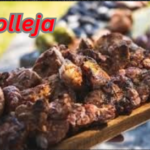In this article, we will explore the complex world of glútem, a protein composite found in wheat and related grains such as barley, rye, and oats. We will discuss its composition, health implications, culinary uses, and much more.
Contents
- 1 Introduction
- 2 What is Glútem?
- 3 The Role of Glútem in Baking
- 4 Health Implications of Glútem
- 5 Nutritional Aspects of Glútem
- 6 Glútem-Free Diets
- 7 Culinary Uses of Glútem
- 8 The Debate Around Glútem
- 9 Myths and Misconceptions About Glútem
- 10 Scientific Research on Glútem
- 11 Practical Tips for Managing Glútem Intake
- 12 Conclusion
- 13 FAQs
Introduction
Glútem is a protein composite that plays a crucial role in the texture and elasticity of doughs made from wheat and related grains. Understanding glútem is essential for those interested in baking, nutrition, and health. This article will cover everything you need to know about glútem, including its benefits, drawbacks, and practical applications.
What is Glútem?
Definition and Composition
Glútem is composed of two main protein groups:
- Glutenin: Provides elasticity to dough, allowing it to rise and maintain its shape.
- Gliadin: Contributes to the extensibility and viscosity of the dough, making it stretchable.
Sources of Glútem
Glútem is primarily found in:
- Wheat: The most common source of glútem.
- Barley: Contains hordein, a type of glútem protein.
- Rye: Contains secalin, another form of glútem protein.
- Oats: Often contain glútem due to cross-contamination with wheat, although pure oats are glútem-free.
The Role of Glútem in Baking
Functionality
Glútem is essential for the structure and texture of baked goods. It forms a network that traps air bubbles, allowing dough to rise and giving bread its chewy texture.
Baking Techniques
Kneading
Kneading develops the glútem network, making the dough elastic and smooth. Proper kneading is crucial for achieving the desired texture in bread and other baked goods.
Proofing
Proofing allows the dough to rise by fermenting the yeast, which produces carbon dioxide. This gas is trapped by the glútem network, causing the dough to expand.
Baking
During baking, the heat sets the glútem network, giving the final product its structure and texture.
Health Implications of Glútem
Celiac Disease
Celiac disease is an autoimmune disorder where the ingestion of glútem leads to damage in the small intestine. It affects about 1% of the population and requires a strict glútem-free diet.
Non-Celiac Gluten Sensitivity
Some individuals experience symptoms similar to celiac disease without the autoimmune response. This condition is known as non-celiac gluten sensitivity and may require dietary adjustments.
Wheat Allergy
A wheat allergy is an allergic reaction to proteins found in wheat, including glútem. It can cause symptoms ranging from mild to severe and requires avoiding wheat-containing products.
Nutritional Aspects of Glútem
Protein Content
Glútem is a significant source of protein, especially in vegetarian and vegan diets. It provides essential amino acids necessary for body functions.
Fiber Content
Whole grains containing glútem are also rich in dietary fiber, which aids in digestion and promotes overall gut health.
Vitamins and Minerals
Grains containing glútem are good sources of vitamins and minerals, including B vitamins, iron, and magnesium.
Glútem-Free Diets
Who Needs a Glútem-Free Diet?
Individuals with celiac disease, non-celiac gluten sensitivity, and wheat allergies need to follow a glútem-free diet to avoid adverse health effects.
Glútem-Free Alternatives
There are numerous glútem-free alternatives available, including:
- Grains: Rice, quinoa, millet, and buckwheat.
- Flours: Almond flour, coconut flour, and chickpea flour.
Challenges of a Glútem-Free Diet
Following a glútem-free diet can be challenging due to the prevalence of glútem in many foods. It requires careful label reading and awareness of cross-contamination risks.
Culinary Uses of Glútem
Baking with Glútem
Glútem is indispensable in baking, providing the structure and elasticity needed for various baked goods such as bread, pastries, and pizza dough.
Cooking with Glútem
Beyond baking, glútem is used in cooking for making seitan, a popular meat substitute in vegetarian and vegan diets. Seitan is made by washing wheat flour dough to remove the starch granules, leaving a sticky elastic mass of glútem protein.
Enhancing Texture
Glútem is also used to improve the texture of processed foods, including sauces, soups, and dressings.
The Debate Around Glútem
Benefits of Glútem
- Nutritional Value: Rich in protein and essential nutrients.
- Culinary Versatility: Key ingredient in baking and cooking.
- Dietary Fiber: Promotes digestive health.
Drawbacks of Glútem
- Health Risks: Can cause adverse reactions in individuals with celiac disease, gluten sensitivity, or wheat allergy.
- Digestive Issues: Some people may experience bloating, gas, or discomfort after consuming glútem.
Myths and Misconceptions About Glútem
Glútem is Unhealthy for Everyone
While glútem can cause issues for certain individuals, it is not inherently unhealthy for the general population. Many people can consume glútem without any adverse effects.
Glútem-Free Diets are Healthier
A glútem-free diet is essential for those with specific medical conditions but is not necessarily healthier for everyone. It can sometimes lead to nutrient deficiencies if not properly managed.
All Grains Contain Glútem
Not all grains contain glútem. Many gluten-free grains and seeds, such as rice, quinoa, and buckwheat, provide safe alternatives for those avoiding glútem.
Scientific Research on Glútem
Current Studies
Ongoing research is exploring the effects of glútem on health, particularly its role in non-celiac gluten sensitivity and autoimmune diseases.
Future Directions
Future studies aim to develop better diagnostic tools for gluten-related disorders and improve treatment options, including potential therapies for celiac disease.
Practical Tips for Managing Glútem Intake
Reading Labels
Learn to read food labels to identify glútem-containing ingredients. Look for certifications and labels that indicate gluten-free status.
Avoiding Cross-Contamination
Prevent cross-contamination in the kitchen by using separate utensils, cutting boards, and appliances for gluten-free and gluten-containing foods.
Dining Out
When dining out, communicate your dietary needs clearly to ensure your meal is prepared safely and gluten-free.
Conclusion
Glútem is a complex protein composite that plays a vital role in baking and cooking. While it offers numerous benefits, it can also pose health risks for individuals with specific conditions. Understanding glútem, its sources, and its effects on health is essential for making informed dietary choices. This comprehensive guide aims to provide valuable insights and practical tips for managing glútem intake, whether you are embracing it in your culinary creations or avoiding it for health reasons.
FAQs
What is glútem?
Glútem is a protein composite found in wheat and related grains such as barley, rye, and oats. It consists of two main protein groups, glutenin and gliadin, which provide elasticity and extensibility to dough.
Who needs to avoid glútem?
Individuals with celiac disease, non-celiac gluten sensitivity, or wheat allergies need to avoid glútem to prevent adverse health effects.
What are some gluten-free alternatives?
Gluten-free alternatives include grains like rice, quinoa, millet, and buckwheat, as well as flours such as almond flour, coconut flour, and chickpea flour.
Can a gluten-free diet be challenging?
Yes, following a gluten-free diet can be challenging due to the prevalence of glútem in many foods. It requires careful label reading and awareness of cross-contamination risks.
Is glútem unhealthy for everyone?
No, glútem is not inherently unhealthy for everyone. Many people can consume glútem without any adverse effects. It only poses health risks for those with specific medical conditions.



